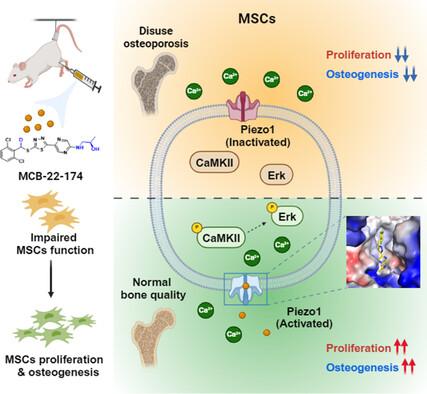一种促进间充质干细胞增殖和骨生成的新型 Piezo1 激动剂,可减轻废用性骨质疏松症
IF 11.1
Q1 MATERIALS SCIENCE, MULTIDISCIPLINARY
引用次数: 0
摘要
废用性骨质疏松症(OP)是一种因缺乏机械刺激而导致的骨质流失状态,可能由长期卧床、神经系统疾病以及微重力诱发。目前,针对废用性骨质疏松症的精确治疗策略在很大程度上仍有待探索。Piezo1是一种对机械力敏感的钙(Ca2+)离子通道,是介导机械传导的关键力传感器,已被证实能调节骨平衡和骨生成以应对机械力。通过基于结构的药物设计,我们开发出了一种新型小分子 Piezo1 激动剂 MCB-22-174,它能有效激活 Piezo1 并启动 Ca2+ 流入,比典型的 Piezo1 激动剂 Yoda1 更有效。此外,MCB-22-174 还是一种安全的 Piezo1 激动剂,没有任何严重的毒性。从机理上讲,Piezo1 通过激活与 Ca2+ 相关的细胞外信号相关激酶和钙钙调蛋白(CaM)依赖性蛋白激酶 II(CaMKII)通路,促进骨髓间充质干细胞的增殖。重要的是,MCB-22-174 能有效促进骨生成并减轻体内废用性 OP。总之,这些发现为通过化学激活 Piezo1 来治疗废用性 OP 提供了一种很有前景的治疗策略。本文章由计算机程序翻译,如有差异,请以英文原文为准。

A Novel Piezo1 Agonist Promoting Mesenchymal Stem Cell Proliferation and Osteogenesis to Attenuate Disuse Osteoporosis
Disuse osteoporosis (OP) is a state of bone loss due to lack of mechanical stimuli, probably induced by prolonged bed rest, neurological diseases, as well as microgravity. Currently the precise treatment strategies of disuse OP remain largely unexplored. Piezo1, a mechanosensitive calcium (Ca2+) ion channel, is a key force sensor mediating mechanotransduction and it is demonstrated to regulate bone homeostasis and osteogenesis in response to mechanical forces. Using structure-based drug design, a novel small-molecule Piezo1 agonist, MCB-22-174, which can effectively activate Piezo1 and initiate Ca2+ influx, is developed and is more potent than the canonical Piezo1 agonist, Yoda1. Moreover, MCB-22-174 is found as a safe Piezo1 agonist without any signs of serious toxicity. Mechanistically, Piezo1 activation promotes the proliferation of bone marrow mesenchymal stem cells by activating the Ca2+-related extracellular signal-related kinases and calcium–calmodulin (CaM)-dependent protein kinase II (CaMKII) pathway. Importantly, MCB-22-174 could effectively promote osteogenesis and attenuate disuse OP in vivo. Overall, the findings provide a promising therapeutic strategy for disuse OP by chemical activation of Piezo1.
求助全文
通过发布文献求助,成功后即可免费获取论文全文。
去求助
来源期刊
CiteScore
14.00
自引率
2.40%
发文量
0
期刊介绍:
Small Science is a premium multidisciplinary open access journal dedicated to publishing impactful research from all areas of nanoscience and nanotechnology. It features interdisciplinary original research and focused review articles on relevant topics. The journal covers design, characterization, mechanism, technology, and application of micro-/nanoscale structures and systems in various fields including physics, chemistry, materials science, engineering, environmental science, life science, biology, and medicine. It welcomes innovative interdisciplinary research and its readership includes professionals from academia and industry in fields such as chemistry, physics, materials science, biology, engineering, and environmental and analytical science. Small Science is indexed and abstracted in CAS, DOAJ, Clarivate Analytics, ProQuest Central, Publicly Available Content Database, Science Database, SCOPUS, and Web of Science.

 求助内容:
求助内容: 应助结果提醒方式:
应助结果提醒方式:


